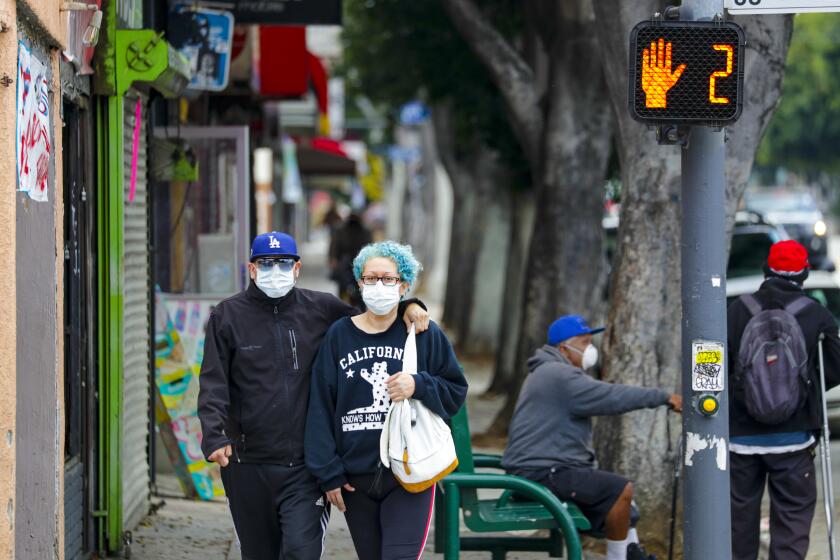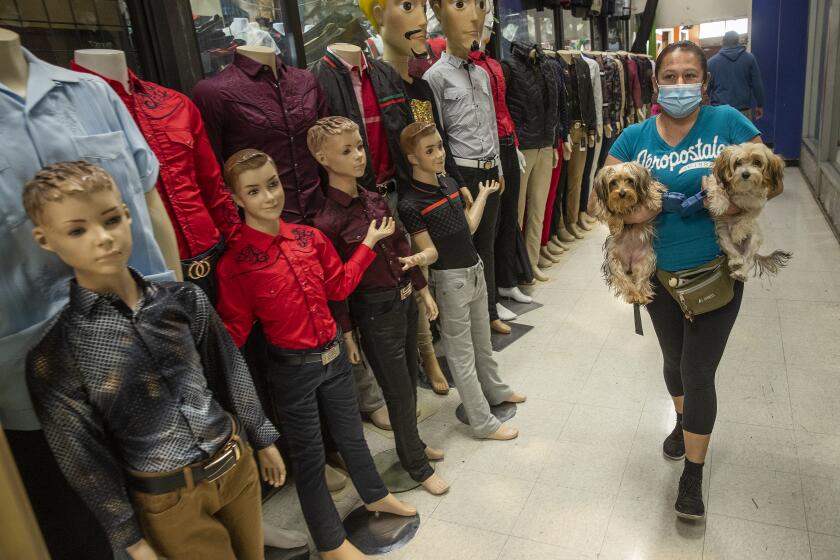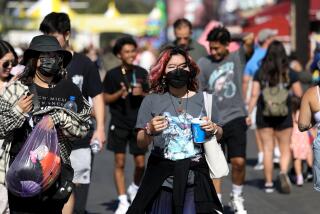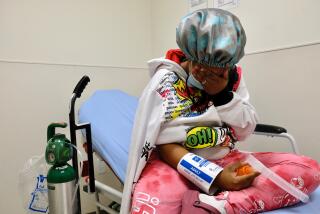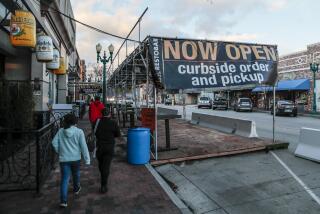In an alarming new record, daily coronavirus cases surpass 10,500 in L.A. County
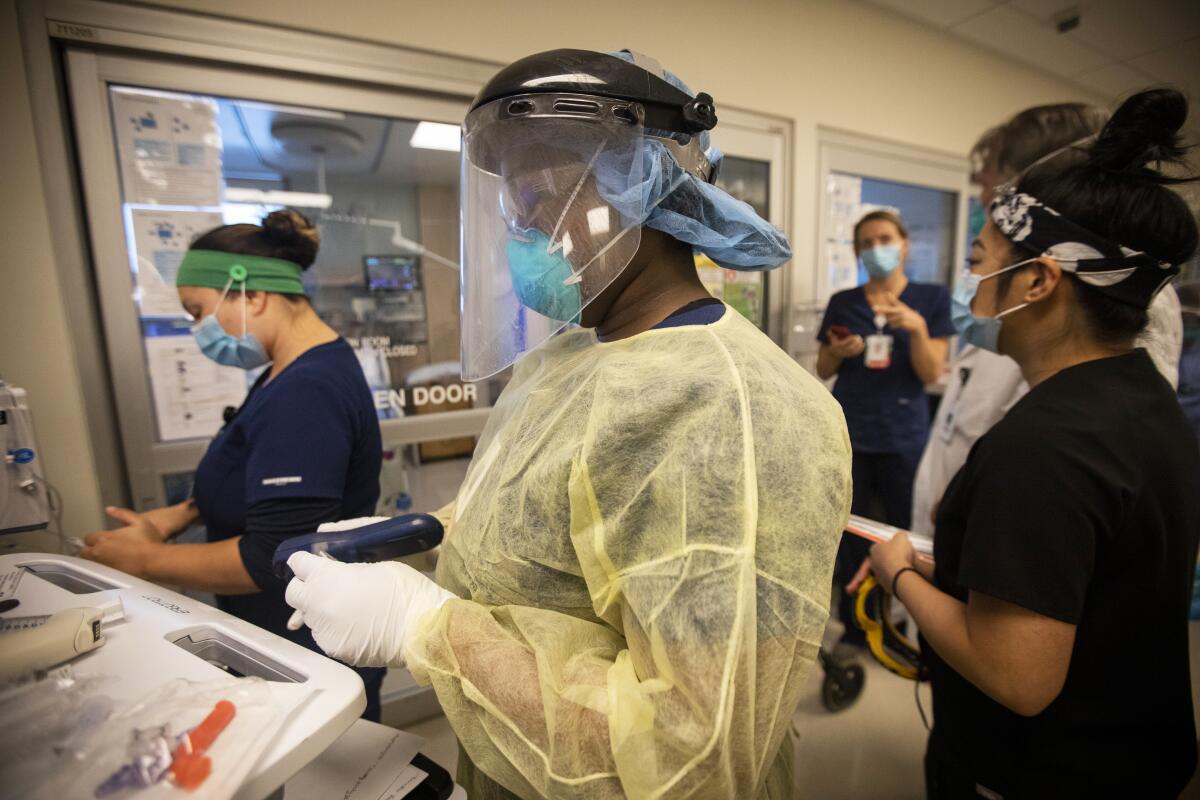
With a new stay-at-home order set to go into effect across much of California late Sunday, hard-hit Los Angeles County reached another alarming milestone in the coronavirus surge, surpassing 10,000 new daily cases.
The county reported 10,528 new cases Sunday and 23 additional deaths. Hospitalizations also reached a new high, with 2,988 patients.
L.A. County has seen an unprecedented increase in coronavirus cases in recent weeks, filling hospitals. Sunday’s numbers underscore concerns that the region has not yet hit its peak.
“I am positive that we haven’t seen the full increases in our case numbers associated with the Thanksgiving holiday, just based on the timeline,” L.A. County Public Health Director Barbara Ferrer said Sunday. She added that it can take two weeks after someone is infected for them to come down with symptoms and even longer for them to suffer serious effects that require hospitalization.
That means that the county’s high number of hospitalizations is associated with cases rates two to three weeks back, when officials were still reporting about 5,000 cases a day. Since then, new cases have roughly doubled.
“I wouldn’t be surprised if we start seeing daily hospitalizations approaching 4,000 in a couple of weeks,” Ferrer said.
In turn, she said, it will take a few more weeks for the effects of the new stay-at-home order to become clear, and in the meantime, the numbers will keep going up.
“We’re going to see three weeks of devastation before we’ll be able to assess the impact,” she said.
The regional stay-at-home order is the latest attempt to tamp down a rise in coronavirus cases and related hospitalizations that officials fear could overwhelm the local healthcare system.
Statewide, average daily coronavirus cases have jumped sixfold since early October, hospitalizations have quadrupled since late October, and average daily deaths have nearly tripled in just the last month.
Last week, L.A. County also saw the largest-ever increase in healthcare worker infections, with over 1,700 new cases, and a doubling of outbreak investigations, which had already doubled from the week before that, Ferrer said. Many of those outbreaks are at workplaces, she said.
“Part of the horror of the terrible place we’re in right now is the cascading ramifications,” she said.
The rising numbers show there’s now widespread community transmission, “which means basically that the virus is everywhere, and therefore we’re applying these stay-at-home orders because of the fact that every place is now at higher risk of transmission,” said Dr. Robert Kim-Farley, professor at the UCLA Fielding School of Public Health, medical epidemiologist and infectious disease expert.
“I think we have moved from characterizing this as a surge, in my mind, to being basically a viral tsunami in terms of its size,” said Kim-Farley, who previously served as a senior official with the L.A. County Department of Public Health.
Gov. Gavin Newsom announced the new stay-at-home order earlier in the week, saying officials had carved up the state into five regions for the purposes of measuring hospital intensive care capacity. A region is required to implement the order after its ICU capacity drops below 15%, a line that Southern California and the San Joaquin Valley had already crossed when the mandate officially took effect Saturday.
The percentages fell further Sunday, from 12.5% to 10.3% for Southern California and from 8.6% to 6.6% for the San Joaquin Valley.
The regions will implement the order at 11:59 p.m. Sunday, and it will remain in place for at least three weeks.
In addition, five counties in the Bay Area have decided to implement the stay-at-home order before reaching the threshold, as early as Sunday night.
For many business owners, the new rules couldn’t have come at a worse time.
Hilary Goldner, co-owner of Sweet 1017 Hairdressing in Seal Beach, heard the news about the order through text messages from her staff. After a busy Saturday, she was getting ready to close her salon for three weeks.
“It’s devastating,” she said. “We had had the two closures already, and this one comes at the busiest time of the year. Everyone is trying to move forward with their lives, and we play a role in that. It’s unfortunate and disappointing.”
Average daily coronavirus cases in California have jumped sixfold since early October; average daily deaths have nearly tripled in just the last month.
The rules differ slightly from California’s first-in-the-nation stay-at-home order, which was considered a success at flattening the infection curve in early May and credited with helping prevent the massive death tolls seen in places such as New York and New Jersey.
Nonessential retail stores can remain open, albeit at a reduced capacity, along with parks, beaches and other outdoor areas.
“I think the reality was that the essential-nonessential framework really disadvantaged many of the smaller retailers,” Ferrer said of the decision to permit all stores to remain open. Officials decided instead to focus on cutting down crowding by having retailers severely limit capacity, put in place metered entrances and ban eating and drinking inside, she said.
L.A. County had already put in place many of the restrictions before the order was announced, requiring restaurants to cease in-person dining; playgrounds, cardrooms and movie theaters to close; and people to stop gathering with non-household members.
But the county will modify its local orders to reflect additional modifications required by the state, which include closing hair salons, barbershops, personal care services, museums, zoos, aquariums and family entertainment centers; limiting all retail to 20% maximum occupancy; and restricting hotels and lodging to critical infrastructure support, officials said.
Ferrer, whose home has been targeted by protesters rallying against the closures, said she understands that people are being asked to make painful sacrifices.
She said she hopes that government officials pass another stimulus package so people don’t have to choose between feeding themselves or paying rent and becoming ill or exposing others.
“I feel like we live in the richest country in the world and yet ... we can’t actually afford somehow to make sure that when we ask people to stay home for three weeks, they have a safety net that actually makes it possible,” she said. “Instead, we have people fighting public health as if we’re the enemy when the virus is our common enemy.”
The order will be felt more dramatically in counties including Orange and Ventura, where more businesses had been permitted to remain open.
Rick Hayes, a retired high school English teacher, was enjoying his daily ritual of coffee and a newspaper outside at the Hangout Restaurant & Beach Bar near Main Street in Seal Beach on Sunday morning.
Asked about the looming lockdown that will put his routine on hold for at least three weeks, Hayes said, “I think it’s unfortunate but probably necessary.”
The 76-year-old, whose mask was pulled down under his chin so he could sip from his mug, appeared to be in the minority wearing a face covering on the popular beachside strip of restaurants in Orange County.
“We got to get this thing under control,” he said. “Covering up seems to help.” He will continue ordering takeout as often as he can during the coming lockdown to try to help local businesses survive, Hayes said.
There was noticeably less support for the restrictions just up the street at Hennessey’s Grill.
“I would really like to see statistics on mental-health-related deaths as a result of this,” said Bob Berk, a retired aerospace engineer, who was having mimosas with his wife and another couple at an outdoor table. “Yes, this is a vicious virus, but you have people who are not just losing their livelihoods but their lives to suicide and stress.
“It’s tragic,” Berk added, “but let the people who are at risk stay home. Don’t quarantine the healthy.”
Leslie Berk, who said she worked for 30 years in dental offices, compared the worry over the coronavirus with the fear that accompanied the arrival of AIDS decades ago. “I seriously considered changing my career, but we didn’t shut the country down.”
HIV, the virus that causes AIDS, is transmitted through intimate contact with blood and semen. Most people get it from unprotected sex or sharing needles. The coronavirus is transmitted through respiratory droplets in the air and on surfaces — you can get it from simply speaking with or touching someone.
“I believe, because of social media, we’re hyper-focusing on this virus,” Leslie Berk said. “Sure it’s bad, but to shut the country down is not OK.”
Starting Sunday at 11:59 p.m., 84% of California’s population will be under new regional stay-at-home restrictions as hospitals’ ICU capacity in Southern California and the San Joaquin Valley plummets.
In addition to some people’s skepticism of science and a pervasive sense of fatigue, there are other challenges that could undermine the effectiveness of the new rules.
The cooler weather has sent more people inside. The holiday season raises the temptation to travel and has people longing to be around others.
There’s also the question of whether people will follow the rules if they don’t face consequences.
As has been the case since the start of the pandemic, many California sheriffs have said they won’t enforce the stay-at-home order.
Orange County Sheriff Don Barnes said Saturday that deputies would not be dispatched to calls involving face coverings, gatherings or stay-at-home rules, calling compliance “a matter of personal responsibility and not a matter of law enforcement.”
Orange County tallied a record number of new coronavirus cases in a single day Sunday: 2,025, surpassing the record-setting 1,966 cases the county reported Saturday. That’s the fourth time in the last two weeks Orange County has notched a single-day record.
The county also hit its fourth consecutive daily record for COVID-19 hospitalizations with 848 people hospitalized, according to data released Sunday; that’s more than five times worse than mid-October, when about 160 were hospitalized.
The new order requires Californians to stay home and minimize their interactions with other households as much as possible.
Riverside County Sheriff Chad Bianco called the new stay-at-home order “flat-out ridiculous” and criticized the state for threatening to cut funding to counties that didn’t comply with the state’s COVID-19 guidelines for reopening. (Riverside County in October ended up modifying a plan to set its own reopening agenda after learning the move could jeopardize tens of millions in state funding.)
“While the governor’s office and the state has threatened action against violators, the Riverside County Sheriff’s Department will not be blackmailed, bullied or used as muscle against Riverside County residents in the enforcement of the governor’s orders,” Bianco said Friday in a videotaped statement.
He singled out Newsom, calling him hypocritical for his handling of the pandemic and alluding to the governor’s much-criticized outing to French Laundry, a pricey Napa Valley restaurant.
“It appears part of the new goal is to shift attention away from his and others’ personal behavior with a do-as-I say-not-as-I-do attitude by turning public opinion against California sheriffs,” Bianco said. “He is expecting us to arrest anyone violating these orders, cite them and take their money, close their businesses, make them stay in their homes and take away their civil liberties, or he will punish all of us.”
Riverside County hit its seventh consecutive daily record for COVID-19 hospitalizations with 687 hospitalized, according to data released Saturday; that’s more than five times worse than early October, when about 135 were hospitalized.
Bars and restaurants were packed during Sunday’s lunch rush on Main Street in Huntington Beach, where drinkers and diners spent one last afternoon at the outdoor restaurants that line the pedestrian thoroughfare.
“The people who own these restaurants have to live, so I have really mixed emotions,” said Leo Sanchez, 47, who was having lunch with a friend at Surf City Ale House. After nearly a year of on again, off again, restrictions, Sanchez sounded resigned and a bit fatalistic.
“The more I see this play out, I feel like maybe all of this was inevitable,” Sanchez said. “Maybe [the virus] has to run through the population and we have to live with the consequences. I’m not happy about that because I have had close friends already who passed away from this situation.”
Standing in the center of the street with a friend, a cigarette and no mask, Saul Emard, 48, said, “Freedom is freedom. If God’s gonna take me, he’s gonna take me. That’s how I feel.”
Emard said he is a general contractor whose work includes jobs at area hospitals, so he’s busier than ever. But the coming stay-at-home order will be economically devastating to friends and family, he said.
“There’s definitely going to be a lot of people out of work,” said Emard’s friend, Michael Pittman. “And with no stimulus, no extension of unemployment benefits, panic starts to set in.”
Times staff writer Sean Greene contributed to this report.
More to Read
Sign up for Essential California
The most important California stories and recommendations in your inbox every morning.
You may occasionally receive promotional content from the Los Angeles Times.
